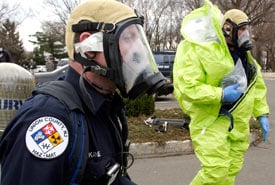
When news of an anthrax attack flashed across American TV screens in September 2001, the public was swept up in a debate that had befuddled government and private researchers for years: What should the United States be doing to protect itself against a bioterrorism attack?
Tara O’Toole, a physician at Johns Hopkins University’s Center for Civilian Biodefense Studies, thought the attack was clearly the work of terrorists. Unless the government began promptly investing billions of dollars to defend against bioterrorism, future germ attacks were inevitable and people worldwide could die by the millions. O’Toole, now director of the Center for Biosecurity at the University of Pittsburgh Medical Center, had conducted war games that predicted as much.
Milton Leitenberg, a University of Maryland scholar who has written extensively about nuclear and biological weapons, was skeptical. He thought the likelihood that a terrorist group could have launched such an attack was being overstated. The government should do a thorough analysis of a full range of biological and terrorism threats facing the nation, including balancing the likelihood of a threat with the potential magnitude of its impact, he believed.
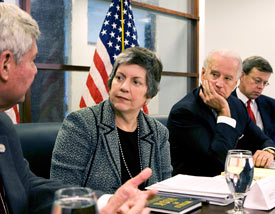 Now, as the new Obama administration takes shape, scientists are continuing that debate, leaving the president-elect with that same vexing question: What should the United States be doing to protect itself against a bioterrorism attack?
Now, as the new Obama administration takes shape, scientists are continuing that debate, leaving the president-elect with that same vexing question: What should the United States be doing to protect itself against a bioterrorism attack?
Barack Obama, the first new president since the 2001 anthrax letter attack rattled America so badly, has the opportunity to take a fresh look at some crucial questions:
- Were post-9/11 claims that terrorist groups could develop their own biological weapons of mass destruction overstated?
- Is it more likely that a terrorist group today might get its hands on a deadly biological weapon by exploiting security lapses at the biodefense facilities opening around the nation?
- Even if the likelihood of terrorists obtaining a germ weapon is less than feared, how do you balance those lower odds against the catastrophic and potentially destabilizing impact such an attack might have on the nation?
Just about every expert agrees that the world faces an increasing risk of biological mischief, violence, accident or terror now that advanced genetic research is being conducted in labs around the world, especially China and India. What they disagree about is how to pursue safety without accelerating risk.
“I think in the palace of truth, the scientific community will tell you that the threat of the development of a (terrorist) biological weapon was vastly overblown,” said Brian Finlay, a senior associate at the Henry L. Stimson Center, a Washington-based think tank dedicated to reducing the threat of weapons of mass destruction.
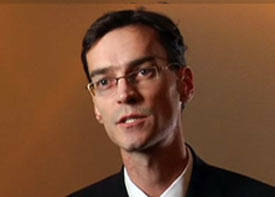 But, he added, “the threat of a successful dissemination of a dangerous pathogen has consequences that are potentially so excessively catastrophic that not investing resources to prevent even a remote chance of this occurrence would be an egregious abrogation of our government’s responsibility to protect Americans.”
But, he added, “the threat of a successful dissemination of a dangerous pathogen has consequences that are potentially so excessively catastrophic that not investing resources to prevent even a remote chance of this occurrence would be an egregious abrogation of our government’s responsibility to protect Americans.”
The federal government began worrying in earnest about a biological terror attack in the 1990s, when O’Toole was part of a small group of policy experts that began warning senior government officials of the threat posed by Biopreparat, the Soviet Union’s immense secret biological weapons program.
Those experts feared that terrorist groups or rogue nations would recruit poorly paid former Soviet bioweapons scientists, or obtain seed cultures of biological warfare agents from poorly secured laboratories in the former Soviet Union.
The policy experts pressed their case all the way to the Oval Office during President Bill Clinton’s second term. They continued the campaign after George W. Bush took office.
As part of that campaign, a group convened at Andrews Air Force Base in June 2001, three months before the anthrax letter attack, for a two-day war game designed to show what would happen if the United States suffered a smallpox terror attack. Former Sen. Sam Nunn was there. So was former FBI director William Sessions.
In the scripted scenario, dubbed “Dark Winter,” a terrorist group released smallpox virus at three locations in Oklahoma. Within 51 days, 3 million people across the United States had been infected, one-third of whom died.
A sequel with a similarly ominous name, “Atlantic Storm,” was held in 2005. This time the fictional scenario had an al-Qaeda splinter group use a commercially available dry-powder dispenser to release a preparation of smallpox virus in six U.S. and foreign cities over four days. Again, the outcome was catastrophic.
“The most striking response from the participants in both exercises was that for the most part, they had no idea that something like this was possible,” said O’Toole, who helped write the script and direct the exercises.
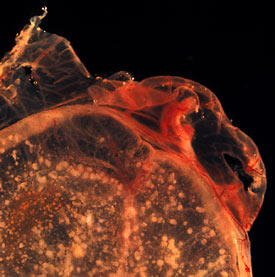 Leitenberg and other experts said O’Toole’s scripted war games greatly exaggerated the ability of terrorist groups to obtain a sample of the smallpox virus (which no longer exist outside defense labs), cultivate it, and convert it into an effective bioweapon.
Leitenberg and other experts said O’Toole’s scripted war games greatly exaggerated the ability of terrorist groups to obtain a sample of the smallpox virus (which no longer exist outside defense labs), cultivate it, and convert it into an effective bioweapon.
“The assumptions that were given for what the terrorists were capable of doing were completely artificial and fantastical,” said Leitenberg, who laid out his case in a sharply worded 115-page booklet titled “Assessing the Biological Weapons and Bioterrorism Threat”, which was published by the U.S. Army War College in December 2005.”No known terrorist group in the world has shown the smallest portion of the capability attributed to them in Dark Winter and Atlantic Storm.”
But Leitenberg said his more temperate views were largely ignored by journalists and congressional staffers who sought him out for his assessment. They were looking for sensationalist predictions, he believed. “For years and years, it was nothing but screaming: âIt’s coming, it’s coming.’ I wasn’t saying, âIt’s going to happen tomorrow.’ I was saying the opposite.”
Seven years after the attack, it seems increasingly likely that Leitenberg’s theory was right. There have been no new attacks and the FBI concluded in July that the sole perpetrator of the 2001 attack was scientist Bruce Ivins, who worked on anthrax vaccines at a U.S. Army biological research center at Fort Detrick, Md.
Although the evidence pinning the attacks on Ivins is circumstantial, few seriously question the evidence linking the anthrax to his lab. Ivins committed suicide before the government could try to prove its theory in court.
Today, O’Toole believes the danger of a mass biological attack by a terrorist group is greater than ever and that huge gaps remain in the country’s preparedness. Vastly more money and public attention are needed, she says.
Her views are supported by a congressionally mandated bipartisan task force, which released a report this week predicting that terrorists would use a weapon of mass destruction â most likely a biological weapon – in an attack somewhere in the world by 2013.
“In our judgment, America’s margin of safety is shrinking, not growing,” the Commission on the Prevention of Weapons of Mass Destruction Proliferation and Terrorism said in its report, World at Risk.
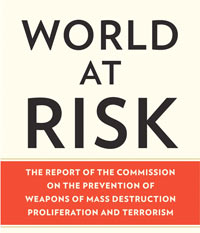
Rep. Jane Harman, D-Calif., head of the Homeland Security Subcommittee on Intelligence & Terrorism Risk Assessment, issued a written response to the report acknowledging the danger of a biological attack but warning, “It’s time to retire the fear card.”
“We need to educate and inform the American people, not terrify them with alarming details about possible threats to the homeland,” Harman said. “While the danger of a terrorist attack using biological, radiological or nuclear weapons is real, preparing the public and training prevention and response teams must be a top priority of the new administration.”
Leitenberg believes now, as he did in 2001, that it’s highly unlikely that a terrorist group is close to developing a bioweapon. Every so often, the 75-year-old researcher calls scientists and security experts inside and outside government, compiling information that helps him gauge whether or not terrorist groups have made any real progress in developing a bioweapon. In August, when he made a round of checks, the answer was still no. He’s still waiting for answers from his latest calls.
The information Leitenberg gathers is by no means definitive – a long history of high-profile intelligence failures bears witness to that. But it is consistent with the views of many scientists who say O’Toole and some political leaders continue to overstate the ease with which a biological weapon can be produced.
âItâs a lot easier than putting together an internal-combustion engine,â says OâToole. Critics of the current policy worry that the people who drove the agenda in the past seven years already have President-elect Obama’s ear. That would mean little reassessment and even less change, they fear.
“We need a complete top-to-bottom review, a complete reassessment,” said Richard H. Ebright, a scientist at the Waksman Institute of Microbiology at Rutgers University in New Jersey. “We need a 180-degree course correction.”










